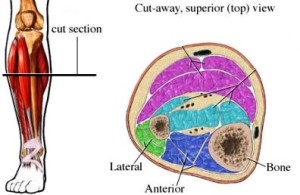 Summer is coming and shin splints are a common problem for people starting activities such as running and walking after a long break. Shin Splints are known medically as Medial Tibial Stress Syndrome. It largely pertains to the pain in the area along or behind the shin bone or tibia. Shin splints occur when a personputs too much pressure or uses the muscles and tendons attached to the shin bone excessively. This is a painful injury and for runners, this can spell the end of continuous training. Treating shin splints can be done and it is a combination of different methods, rest and pain management procedures.
Summer is coming and shin splints are a common problem for people starting activities such as running and walking after a long break. Shin Splints are known medically as Medial Tibial Stress Syndrome. It largely pertains to the pain in the area along or behind the shin bone or tibia. Shin splints occur when a personputs too much pressure or uses the muscles and tendons attached to the shin bone excessively. This is a painful injury and for runners, this can spell the end of continuous training. Treating shin splints can be done and it is a combination of different methods, rest and pain management procedures.
It is very important however, especially for training runners to identify the root of the problem that leads to shin splints and act upon them. Correcting these problems also lead to faster rehabilitation.
How do I know if I have a shin splint?
The aches and pains caused by shin splints can range from being mild to severe. Often when people start feeling extreme pain they confuse the symptom with a fracture or a muscle tear. The beginning symptoms of shin splints are easy to recognize:
- Dull ache in front of the shin which seems to be gradually progressing
- Throbbing near the shin muscles
- Tenderness along the shin bone ranging from 2 to 6 inches area
These symptoms indicate that there is discomfort in the tendons which lie in front of the lower part of the leg. The pain caused by shin splints usually begins when you start running and then seems to fade away as the muscles are relaxed.
Check for Incorrect Running Technique
Shin splints are linked to the excess use of muscles around the tibia and one of the culprits is an improper running technique. These encompass the incorrect position of the foot and legs upon impact to the ground, uneven weight distribution while running or during workouts, and the improper pacing of one’s exercise routines or activities. Improper foot position causes unevenness of weight distribution that gives undue stress to the leg area that can trigger shin splints. Improper pacing on the other hand includes sporadic changes in the intensity of workouts. This is a very unsafe practice that increases the risk of having an injury including the development of shin splints.
Physiological Factors
Shin splints can originate from improper running biomechanics. Keeping in this in mind one must consider correcting or compensating for physiological factors that may affect our running stride. Fitness of the leg area and core muscles are very important but factors likepronation and foot arch very much affect our biomechanics.Identifying these factors would therefore lead to the selection of proper footwear.
Proper Footwear
Aside from proper fitting shoes, using the correct type of footwear for shin splints is very important in all types of active routines, especially on running. There are shoes that have been designed and made to address certain issues of concern amongst different activities. Different sports or activities need different types of shoes.Most shoes on the market are made to provide adequate traction, correct posture, and provide cushioning for the exact activity that they are to be used.Using incorrectfootwear can result to improper posture and leadundue stress to the legs that can start shin splints.
Our individual running biomechanics dictate the type of footwear that will better compliment our running stride to ensure correct posture.
After deciding upon the shape of footwear most suitable for you it’s time to choose the type of shoe based on your running biomechanics. Stability shoes reduce the mild forward leaning tendency characteristic of runners that that exhibit mild overpronation / have neutral arches. Cushioningshoes on the other hand feature shock absorption and are for flat-footed individuals or supinators. Motion control shoes are designed to control moderate to severe overpronation.
Alternate Workout Routines
Keeping fit during the onset of shin splints and its symptoms can be hard.Pain will initially halt any activity but having shin splints should not mean the end of your workout routine.The utilization of non-impact workout routineswill allow continued fitness maintenance while allowing recovery from shin splints.
One perfect example is running in deep water. Doing the running motion in water has very minimal impact. What’s even better is that it is more of a whole body workout which lies in working through water resistance.
Other examples of non-impact workouts are rowing and cross-training. Cross-training improves the core and enhances running biomechanics. Doing varied work outs also helps as shin splints are triggered by repetitive stress. In the event that running is inevitable, do choose to run or walk on soft surfaces like trails or grassy ground.
Stretching and massaging the lower leg area enhances blood flow and eases tensed muscles. Do these before your routines. Identifying and correcting factors that may cause the onset of shin splints and its symptoms is a huge step in rehabilitation and being able to run once again.
